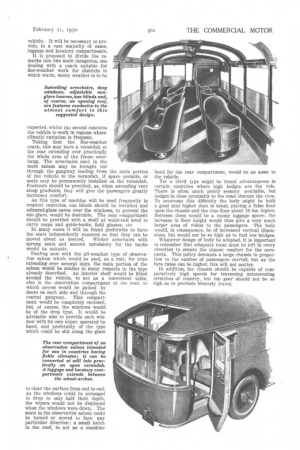The Possibilities of
Page 114

Page 115

If you've noticed an error in this article please click here to report it so we can fix it.
THE S SE VATION SALOON COACH
DURING recent years the motor coach has made rapid strides in popularity, particularly as a means for conveyance on pleasure trips. Generally speaking, excursions are of two types, either a trip to a given point, the main object of the run being to reach the place in question, whilst the journey itself is of secondary importance; or a form of excursion in which the journey itself is of primary importance.
For the former class of work, the existing coach is a highly satisfactory proposition, but for the sightseer the conventional vehicle is lacking in several respects.
In this country there are many areas, such, for example, as the Lake District, Devon and Cornwall, and Shakespeare's country, in which observation saloons could be used with advantage. Abroad there are still greater possibilities. It should be borne in mind that the class of passenger for whom this vehicle will be provided will be prepared to pay relatively high fares. Therefore, a large chassis can be used as the basis for a body housing a comparatively small number of passengers.
In all cases, deep windows are essential, as they permit a very wide angle of view, which is of great value in mountainous regions. Not only must the waist-rail he kept low, but the cant-rail also should be high in order that niountain tops may be seen without having to bend down and look upward. Another essential is the use of narrow window pillars.
One of the vital features of all observation type vehicles is the sunshine roof, preferably permitting a practically unobstructed vision from cant-rail to cantrail and from the front bulkhead to within about 4 ft. of the extreme rear of the expected, whilst the second concerns the vehicle to work in regions where climatic variation is frequent. vehicle. It will be necessary to provide, in a vast majority of cases, luggage and lavatory compartments.
It is proposed to divide the remarks into two main categories, one dealing with a coach suitable for fine-weather work for districts in which warm, sunny weather is to be Taking first the fine-weather coach, this may have a verandah at the rear extending over practically the whole area of the frame overhang. The armchairs used in the main saloon may be brought out through the gangway leading from the main portion of the vehicle to the verandah, if space permits, or seats may be permanently installed on the verandah. Footrests should be provided, as, when ascending very steep gradients, they will give the passengers greatly increased comfort.
As this type of machine will be used frequently in tropical countries, sun blinds should be installed and coloured-glass eaves over the windows, to prevent the sun glare, would be desirable. The rear compartment should be provided with a shelf at waist-rail level to carry maps and guide-books, field glasses, etc.
In many cases it will be found preferable to have the seats independently mounted so that they can be moved about as desired. Wicker armchairs with sprung seats and smooth upholstery for the backs would be suitable.
Dealing now with the all-weather type of observation saloon which would be used, as a rule, for trips extending over several days, the main portion of the saloon would be similar in many respects to the type already described. An interior shelf would be fitted around the vehicle, to act as a convenient table, also in the observation compartment at the rear, to which access would be gained by doors on each side and through the central gangway. This compartment would be completely enclosed, but, of course, the windows would be of the drop type. It would be advisable also to provide each window with its own wiper, operated by hand, and preferably of the type which could be slid along the glass
to clear the surface from end to end. As the windows could be arranged to drop to only half their depth, the wipers would not be displaced when the windows were down. The seats in the observation saloon could be turned or moved to face any particular direction; a small hatch in the roof, to act as a sunshine head for the rear compartment, would be an asset to the vehicle.
Yet a third type might be found advantageous in certain countries where high hedges are the rule. There is often much pretty scenery available, but hedges in close proximity to the road obscure the view. To overcome this difficulty the body might be built a good deal higher than is usual, placing a false floor upon the chassis and the true floor about 18 ins. higher. Between them would be a roomy luggage space; the increase in floor height would thus give a very much larger area of vision to the passengers. The body would, in consequence, be of increased vertical dimensions, but would not be so high as to foul low bridges.
Whatever design of body he adopted, it is important to remember that adequate room must be left in every direction to ensure the utmost comfort for the occupants. This policy demands a large chassis in proportion to the number of passengers carried, but as the fare rates can be higher, this will not matter.
In addition, the chassis should be capable of comparatively high speeds for traversing uninteresting stretches of country, but top gear should not be so high as to preclude leisurely travel.




























































































































































































































